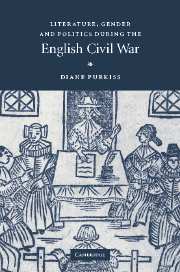Book contents
1 - Dismembering and remembering: the English Civil War and male identity
Published online by Cambridge University Press: 22 September 2009
Summary
The battle of Edgehill, the first major battle of the English Civil War, was fought in the bitter cold of October 1642. By the Christmas season of that year, this first battle was being re-membered and re-enacted in a new and strange manner. The London diary of John Greene reports that
There are now divers reports of strange sights seen, and strange noyses heard at Edgehill where our last battle was fought; in the place wher the Kings army stood terrible outcries; wher the Parliaments [stood] music and singing.
Another account described the apparitions in terms of the horror of the battle:
Edgehill: ‘whose troubles peese of earth plastred with English goare and turned into a Golgotha of bones is now become the plot of feare and horrour, whose earth now groaning with the weight of lives whose lest beds there were maid to sleepe oupon, rests in [ellipsis in text] Whose dying grones a second time revive breking the cauernes of the courng earth, and sends both feare and horour round about to terifie the living with dead soules, which first amazing wonder began.
while a pamphlet recorded that
portentious apparitions of two jarring and contrary armies where the battell was strucken, were seen at Edge Hill, where are still many unburied karkassess, at between twelve and one of the clock in the morning … These infernal souldiers appeared on Christmas night, and again on two Saturdays after, bearing the kings and Parliaments colours. […]
- Type
- Chapter
- Information
- Publisher: Cambridge University PressPrint publication year: 2005



